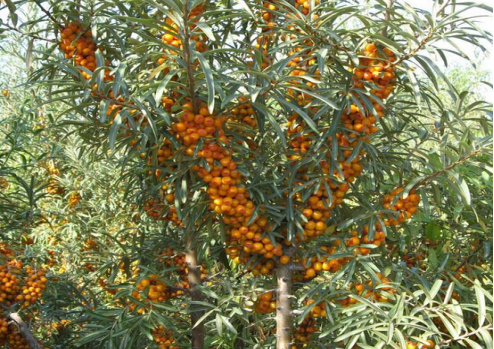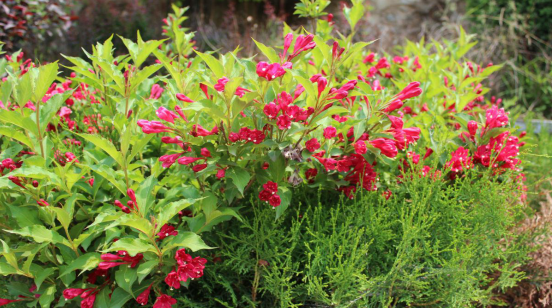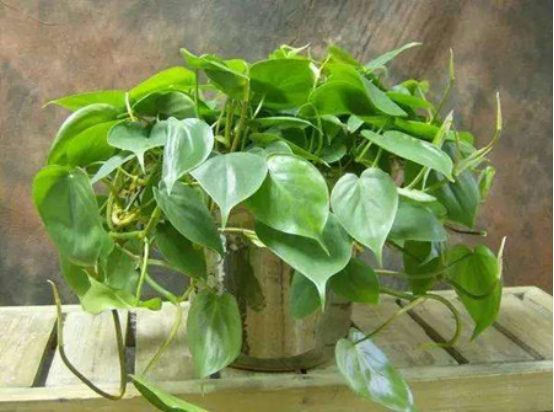Culture methods of Hippophae rhamnoides
Light, temperature
In fact, seabuckthorn temperature requirements are not too strict, very resistant to hot and cold, down to-50 ℃, up to 50 ℃, is not a problem. Hippophae rhamnoides likes light, and the annual sunshine hours are as long as possible.
Moisture content
Hippophae rhamnoides is very resistant to barren, annual precipitation of more than 400 mm can survive, but should pay attention to avoid stagnant water, timely drainage in the rainy season.
Fertilizer application
Timely fertilization should be applied in the flower bud stage and fruit stage of Hippophae rhamnoides to increase nutrients and ensure the high quality and high yield of the fruit.

Soil
Hippophae rhamnoides is very adaptable to soil. It is best to choose gravel soil, sandy soil and other soil with good permeability, but do not use soil that is too sticky.
Matters needing attention
When Hippophae rhamnoides grows to 2-2.5 meters high, it needs to be clipped.
Pest control
The main disease of Hippophae rhamnoides is dry shrinkage disease, the main pests are apple leaf moth, spring inchworm, seabuckthorn aphid. Wait.
In order to prevent and cure dry shrinkage disease, disease-resistant varieties should be selected when planting seabuckthorn, management should be strengthened, soil should be loosened regularly, soil permeability should be improved and disease resistance should be enhanced. Chemical control can be carried out in late April, and the corresponding drugs can be irrigated once a month for 3-5 times.
For pests, they can be sprayed with drugs corresponding to the disease for treatment and prevention.
After introducing the cultivation of Hippophae rhamnoides, let's take a look at how seabuckthorn is cut!
Culture methods and matters needing attention of Hippophae rhamnoides
Cultivation methods of Hippophae rhamnoides L.
Hippophae rhamnoides is lax in temperature and extremely resistant to cold and heat, with a minimum tolerance of-50 ℃ and a maximum of 50 ℃. Hippophae rhamnoides is a positive tree species, like light, the annual sunshine hours should be 1500-3300 hours.
Moisture content
Hippophae rhamnoides is barren and requires annual precipitation of more than 400 mm, but it can also grow normally if it is planted in valleys or floodplains. In addition, attention should be paid to avoiding stagnant water and timely drainage in the rainy season.
Fertilizer application
During the flower bud stage and fruit period of Hippophae rhamnoides, Zhuangguotiling should be sprayed in time to increase nutrients, prevent falling flowers, increase fruit setting rate, accelerate its expansion and ensure high quality and high yield of fruit.
Soil
Hippophae rhamnoides has strong adaptability to soil. It is suitable to choose gravel soil and sandy soil with good permeability, but avoid too clayey soil.
Matters needing attention in the Culture of Hippophae rhamnoides
When Hippophae rhamnoides grows to a height of about 2-2.5 meters, it needs to be clipped. If you do not fight horizontally, the old should be kept new, the secret places should be trimmed, the branches should be left empty, the canopy should be trimmed well, and the crown will have a high yield.
Pest control
Dry shrinkage disease is the main disease of Hippophae rhamnoides, while the common pests of Hippophae rhamnoides are seabuckthorn aphids, spring inchworm, apple leaf moth and so on.
For the specific prevention and control of dry shrinkage disease of Hippophae rhamnoides, disease-resistant varieties should be selected when planting seabuckthorn, at the same time, management should be strengthened, soil should be loosened regularly, soil permeability should be improved and plant disease resistance should be enhanced. Chemical control can be carried out in late April. 40% carbendazim glue suspension 500 times or methyl topiramate 800 times can be irrigated once a month for 3-5 times in a row.
The harm of aphids can be prevented by spraying 2500-3000 times of imidacloprid. For the harm of apple leaf moth and spring inchworm, it can be sprayed with 3000-fold solution, or 2500-fold solution can be used to control.
Cultivation and management of seabuckthorn Hippophae rhamnoides, also known as vinegar willow, acid thorn, black thorn, belongs to the genus Hippophae rhamnoides of Elaeagnaceae, is a deciduous shrub with symbiotic nitrogen fixation ability. Plants up to 3 m to 10 m high, with stout spines, young branches densely covered with brown rust scales. Leaves alternate or subopposite, 2 cm to 6 cm long and 0.4 cm to 1.2 cm wide, both ends obtusely pointed, abaxially densely covered with white scales. The flowers are yellowish, small, dioecious, flowering from March to April. The fruit is nearly spherical, orange or red, and the fruit ripens from September to October.
Seabuckthorn is widely distributed in Eurasia. There are large areas of cultivation in Northwest, North China, Northeast and Southwest of China. 1. Hippophae rhamnoides can be cultured by seed, root tiller, hardwood cuttage, tender wood cuttage and so on. Seed breeding: soak the seeds in 40 ℃ to 60 ℃ warm water for 24 to 28 hours, put 2% potassium permanganate in warm water to disinfect the seeds, soak them out and mix them into the river sand to accelerate germination, and then sow seeds when there is a crack mouth of 1 inch 3. The sowing rate is about 10 jin per mu, strip sowing is used, the row spacing is 25 cm to 30 cm, and the seed cover is 2 cm. Before sowing, the nursery should be fully fertilized, the bottom water should be irrigated, the border should be smooth, and the soil on the bed should be kept moist after sowing. Root tiller culture: select 1-2-year-old well-developed root tillers in the year of planting, cut off the roots at 10 cm to 20 cm from the trunk, and mark the female or male plants respectively. After survival, it was transferred to the planting ground for cultivation. Hardwood cuttings: in early spring, select cuttings that are robust, disease-free and completely lignified. Cuttings are 15 cm to 20 cm long and 0.5 cm to 1 cm thick. Keep 3 to 4 full buds. After cutting, soak them in bundles of 50 to 100 strips, soak for 24 to 48 hours, soak only 3 cm to 4 cm of roots. In order to promote rooting, you can use ABTl rooting powder 50ppm to 100ppm, soak for 10 to 24 hours, immediately cut after soaking, keep the bed temperature from 25 ℃ to 28 ℃, spray through water, and then keep the bed soil moist, seedling height 15 cm to 20 cm, seedling refinement for 7 to 10 days, transfer to nursery or planting ground for cultivation. Softwood cuttings: choose mother trees with good growth and fruit from June to July. The strip is 12cm to 15cm long and 0.5cm to 1cm thick, with only top leaves, other leaves removed, soaked in ABT rooting powder, immersed in plastic greenhouse or greenhouse, shade management. When the seedling height is 15 cm to 20 cm and the seedlings are refined for 7 to 10 days, the seedlings are moved to the nursery for pseudo-planting management and planted in autumn or next spring. 2. Cultivation and management the planting density of Hippophae rhamnoides depends on the tree strength of the variety, so it is convenient for mechanized tending. In order to pollinate, a row of pure female plants and a row of female and male plants should be planted alternately. Planting should be done well, dig a good pit, apply bottom fertilizer where possible, immediately irrigate the root water after planting, and seal the cracks with soil after irrigation. Results in the first 4 years, weeding should be ploughed every year, and some urea should be applied in the rainy season where there are conditions. Pruning is carried out every spring to remove excess dry and withered branches, disease and insect branches and improve tree lighting. There are few diseases and insect pests in Hippophae rhamnoides, so pesticides should be sprayed in time when diseases and insect pests are found. By strengthening management, the utilization value of Hippophae rhamnoides can be better improved.
- Prev

Culture method of brocade flower
The soil brocade flower has strong adaptability, is easy to cultivate and grows rapidly. generally, sandy soil with good drainage needs to be selected as the cultivated soil, and there are a variety of propagation methods, such as sowing, cutting and striping. Take sowing as an example, it is necessary to sow in windless weather.
- Next

Culture method of Tripterygium paniculata
1. Supplementary fertilizer: the heart-leaf vine needs to apply water-soluble fertilizer during the growing season, which is beneficial to the initial growth of the heart-leaf vine, which can be fertilized once or twice a month; on the contrary, it needs to stop fertilization in autumn and winter, because the heart-leaf vine almost stops growing in autumn and winter
Related
- Fuxing push coffee new agricultural production and marketing class: lack of small-scale processing plants
- Jujube rice field leisure farm deep ploughing Yilan for five years to create a space for organic food and play
- Nongyu Farm-A trial of organic papaya for brave women with advanced technology
- Four points for attention in the prevention and control of diseases and insect pests of edible fungi
- How to add nutrient solution to Edible Fungi
- Is there any good way to control edible fungus mites?
- Open Inoculation Technology of Edible Fungi
- Is there any clever way to use fertilizer for edible fungus in winter?
- What agents are used to kill the pathogens of edible fungi in the mushroom shed?
- Rapid drying of Edible Fungi

